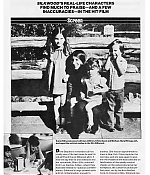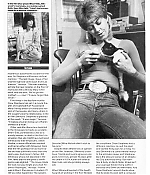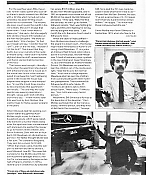
|
Silkwood's Real Life Characters
People Magazine ·
February 20, 1984
· Written by Peter Carlson
|
Silkwood’s real-life characters find much to praise – and a few inaccuracies – in the hit film. Drew Stephens remembers all too vividly one of the last times he saw his old girlfried Karen Silkwood alive. It was the day that he and Silkwood and her roommate, Sherri Ellis, returned from Los Alamos, New Mexico, where they had been tested for radiation contamination. Silkwood’s lungs showed quite a bit of contamination, enough to scare her, but she was feeling spunky anyway. She had an appointment to meet a New York Times reporter the next day, and she was eager to give him the evidence she had collected on falsification of the quality-control checks on the rods produced at her workplace, the Cimarron plutonium-fuel plant, run by the Kerr-Mc-Gee Corp. in Crescent, Oklahoma. Silkwood never reached the reporter. She died in a mysterious automobile accident on the way. So Stephens still savors his final memory. “The last image I have of her was the night we came back from Los Alamos,” he says. “She was standing astride the heat register on the floor of my house with a Bloody Mary in her hand, and she said, “We’ve got the motherfuckers now.” I’ll never forget that, never.”
Five times in the last few months Drew Stephens has sat in a movie theater and watched Kurt Russell and Meryl Streep enact a fictionalized version of that scene, and many others the couple’s stormy relationship, in the hit film “Silkwood”. Stephens is pleased at the result. “It was magic,” he says. “It makes a human being out of Karen instead of a myth.” Other real-life characters decipted in the movie are not quite so ecstatic. Sherri Ellis, portrayed by Cher as a moody lesbian, is irked at the film’s insuniation that she might have betrayed Silkwood to their employers. Steve Wodka, a union official who worked and had an affair with Silkwood, feels that the film portrays her as a more naive and less politically savvy than she really was. And Karen’s father, Bill Silkwood, who is not depicted in the film, feels that his daughter’s intelligence was slightened. “THe movie made her look not very bright and a hick Tobacco Road type,” he says. “Karen was brilliant. She was an A student. I’ll tell you what happened. The lawyers were scared of that damn movie, and [director] Mike Nichols didn’t stick to his guns.” Despite the differences of opinion on the film, however, Silkwood’s relatives, friends and lovers agree on one point. Even now, almost 10 years after her death in 1974, Karen still affects their lives, and she probably always will. When Silkwood learned of the health hazards of working in the Kerr-McGee plant, she led a union fight to change the conditions. Drew Stephens had a different reaction. He quit the plant and started fixing cars for a living. Today Silkwood is a controversial martyr to the antinuke cause, and Stephens, 33, is the obscure owner of an Oklahoma City auto-body shop. But Hammer & Dolly on North Miller Street isn’t your average fender-fixing outfit; it services only BMW and Mercedes. And Drew Stephens’ smooth hands show that he does his work with a computer not with a wrench.
A successful businessman recently engaged to be married, Stephens has built a new life. After Karen’s death, howver, he was “angry, real angry,” he says, “mad at God for doing things I couldn’t understand.” For a time he tried to submerge that anger in alcohol. Now, with the help of friends and time, he has made peace with himself and his past. “Look, it was a chicken–deal,” he says. “People aren’t supposed to go to work in a shiny new nuclear plant like I did and then see it just go to hell before their eyes and end up with all kinds of questions about what the radiation has done to them.” Stephens is haunted by his memories of Karen and troubled by vague thoughts that if he had done something else, she would still be alive. “baking pies and taking care of her children. I guess I’ll always have the feeling that maybe I could have done something,” he says. “maybe it could have ended differently.”
Dressed in jeans, a tight red T-shirt and a military-style jacket, Sherri Ellis is sipping her version of an Angel’s Kiss (cognac and Grand Marnier) in a Gutherie, Okla. bar and talking about “Silkwood”. “It really spun my head,” she says. “I prayed it would be made into a movie, but I didn’t believe it until I saw it. I’ll only have a complaint if there’s no sequel, “The Murder of Karen Silkwood”. She voices no objections to being portrayed as a lesbian in the film and declines to confirm or deny the accuracy of that characterization. “I’m a virgin,” she jokes, “and so is everybody else in Oklahoma.” But another aspect of the movie riles. “The upsetting thing is the insinuation to I could have snitched on Karen to the company,” she says. “But I sold the producers of the film the character-portrayal rights, and for $67,500 they can defame my character any way they want.” That money – which, thanks to Sherri’s bargaining, was about $65,000 more than Drew Stephens received (although he earned thousands of dollars as a technical adviser) – paid for a house about a mile outside of Gutrhie. It is a ramshackle place with no telephone and only a wood-burning stove toward off the bitter Oklahome winters, but Ellis, 30, likes it. “I found this piece of real estate and I found peace of mind,” she says. “I can handle the memories now”. For the past few years Ellis, the erratic former rodeo queen who soon after Karen’s death invaded Kerr-McGee with a .22 rifle which turned out to be unloaded, has been writing a book about her old roomate. The volume, she says, could reveal the culprint in Karen’s death. She won’t divulge that name now – “I don’t even want to tease you,” she says – but she eagerly tells stories of bouts with radiation at the Kerr-McGee plant. “We were exposed daily,” Ellis charges. “At first you’d laugh and say, “I wonder how hot I am? Later on th eline was, “I wonder if I hit the limit? That meant that they had to bury your overalls in the nuclear-waste dump. I really didn’t have the slightest idea the stuff caused cancer until Karen started making mention of the fact.” That lesson was brought – literally – home when the apartment she shared with Silkwood (it was not a house as in the movie) was found to be contaminated,. In perhaps the most frightening scene in the movie the house was emptied and stripped in one frenzied day. “In real life it took three months to decontaminate that apeartment,” she recalls. “The only way we could reenter was wearing respirators. I thought, Jesus, and I work with this stuff every day.” A few months later Ellis was fired by Kerr-McGee. She claims it was for flying a paper airplane in the plant.
When Silkwood died her painting-contractor father thought that Kerr-McGee ought to pay for Karen’s household goods, which were reportedly buried in a nuclear-waste dump after the apartment was contaminated with plutonium. He wanted to money to go to Karen’s three children, who live in Ardmore, Okla. with her ex-husband, Bill Meadows, an oil pipeline supervisor. Her father hought $5,000 was a fair sum. The company disagreed. They sent him a check for $1,500. “When that check came, I told the lawyers to tell Kerr-McGee to shove it,” says Silkwood, now 59. They sued the company for the $5,000, plus $10 million in punitive damages and $1,5 million for compensatory damages on behalf of Karen’s children. In 1979 a federal jury in Oklahoma City awarded her estate $10,5 million, plus the $5,000. Kerr-McGee appealed, and in 1981 an appeals court threw out all but $5,000 of the award. But Bill Silkwood persisted. “They said, ‘Well, this’ll be the last step, he can’t go no further,'” Silkwood recalls. “But I was fighting for right, and they were fighting for wrong, and my daughter was dead.” Last month the U.S. Surpreme Court ruled in Silkwood’s favor. When the case is finally settled – Kerr-McGee now plans to challenge the award in a lower court – the money might make millionaires of Karen’s off-spring. Kristi Meadows, 17, is a junior at Ardmore High School, where she is active in school plays. Michael Meadows, 14 and a freshman, plays cymbals in the marching band. Dawn Meadows, 13, is a cheerleader at Ardmore Middle School. Bill Meadows has steadfastly kept his children out of the media spotlight. “Dad wants us to live normal lives,” Kristi told a college reporter. Meadows also has kept the children from communicating with their maternal grandparents. That torments Bill Silkwood and his wife, Merle, 57. “I’d like to be able to talk to them about Karen,” Merle says. “I’d like to say, ‘Your mom was a very heroic person.'” Meanwhile, Bill Silkwood is furious at the deception of his daughter. “Kerr-McGee portrayed her at the trial as a dopey, immoral person and they kind of did that in the movie, too,” he says. Still, he is glad the film was made because it does what Karen tried to do – expose Kerr-McGee. Besides, he says, “I’ve got a percentage of it, if it makes more than two hundred billion trillion dollars.” He laughs, “You know how those Hollywood Bandits are.”
Steve Wodka met Karen Silkwood in September 1974, when she flew to the Washington D.C. office of the Oil, Chemical and Atomic Workers Union with information on safety hazards in the Cimarron plant. “She was giving us places, times, dates, people’s names,” says Wodka, 34, who now is a toxic-chemicals specialist at a law firm in the capital. “We thought she was credible, that this was someone who was trying to be very careful.” Wodka also noticed attributes in Karen that he says aren’t recognized in the movie. “She was a little more politically aware of what was going on than Streep portrays her.” In the next two months, as Silkwood gathered more information in order to document her charges, she met with Wodka a couple of times in Oklahoma. “She was a woman who was taking some risks, who was brave,” says Wodka. “I’ve always found that very attractive. It brings out certain points of your personality that I would say are sexy.” It was Wodka who arranged the meeting between Silkwood and David Burnham of the New York Times. On the night of November 13, 1974, Wodka, Burnham and Stephens waited for Karen in an Oklahoma City Holiday Inn. When Silkwood was more than an hour late, Wodka called a local union official and learned of her fatal accident. “Drew was sitting right next to me,” he recalls. “I hung up and I told him, ‘Drew, she’s dead.'” The next day the three men obtained from the garage the cardboard box in which her possessions had been placed and looked for the documents she had promised to bring Burnham. They were gone. “That was the point when we said, ‘Something is going on,'” notes Wodka.
He remains unsatisfied with the outcome of the Silkwood case. “I’m tired of this being described as a ‘mysterious automobile crash,’ he says. “I would like to see an independent comprehensive investigation by a special prosecutor with a full subpoena power. We need to get to the bottom of it. I firmly think that there’s somebody rolling around Oklahoma right now who did it. And that person needs to be brough to justice.”













